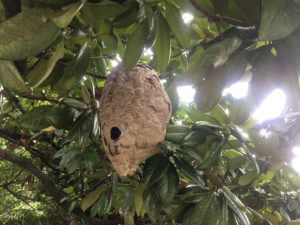While stinging insect nests can be pretty scary to deal with, hornets may pose the most danger of all. Hornet nests, known for their large size and their football-like shape, often attach to trees and shrubs. Here is a look at these creatures, how to tell them apart, and what to do about hornet nest removal.
Two main kinds of hornets live in the area; the bald faced hornet and the European hornet. Bald faced hornets have the well-known football nests that hang prominently from branches. These nests last one season. Biologically, they are not considered true hornets but are wasps. Like wasps, they defend their nests fiercely. They can chase you for long distances, stinging over and over again. The European hornet is shier. It is a true hornet, building nests further from homes; they like nesting around rocks and trees but will use cavities of outbuildings sometimes. Though they are nicknamed gentle giants, they will defend their nest with similar fierceness.
When approaching a hornet’s nest, professionals rely on a lot of gear to protect themselves from these fierce creatures. This will include ladders and climbing gear to get to high nests. Because there is a high likelihood of attack, you should be well-secured when going high to prevent falls. The pros also wear protective equipment similar to what beekeepers wear to prevent stings. Since hornets can sting through clothing, it is important to be well-prepared.
If you have hornets, the safest method of hornet nest removal is to call a professional. The risk of stings, as well as the risk of falling from a high place while dealing with them, is very high.


